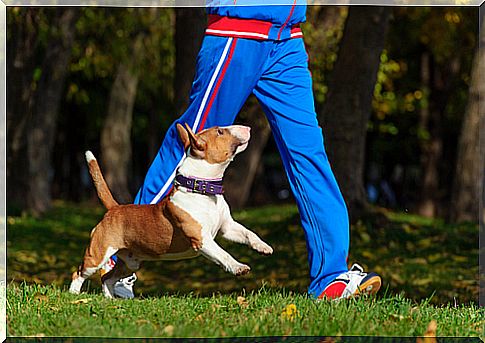How To Fight Your Dog’s Joint Pain

At any age, our furry darlings can have problems with their joints. Therefore, we tell you factors, signs and ways to fight your dog’s joint pain. You must be attentive to this issue to be able to treat it in a timely manner and avoid major inconveniences for your pet.
Main causes of joint pain in your dog
The most common cause of joint pain in dogs is usually arthritis. But it can also be due to:
- Common injuries, such as strains and sprains
- Hip dysplasia
- Lack of exercise
- Obesity
- Poor nutrition
A dog can suffer from joint pain at any age. Therefore, you should be attentive to if it shows signs of being suffering from this health problem and consult your veterinarian immediately.
Signs that your furry has joint pain

Among the signs that may indicate that your furry feels pain in its joints we can point out:
- Unusual movements
- Disadvantages to get up
- Limp
- Walking stiffly
- Swollen joints
- Difficulty stretching
- Licking of affected areas
- Irritability
- Lack of will to perform certain physical activities, such as jumping or climbing stairs
- Refusing to walk, when the pain is very intense
If you detect that your furry presents any of these signs of joint pain, take him immediately to the vet. Without a doubt, no one better than an expert will be able to correctly diagnose what happens to your pet.
Treatments for your dog’s joint pain
The first thing that a suitable professional will indicate to you is a treatment to reduce the inflammation and pain that your four-legged friend is suffering.
Surely, he will prescribe some non-steroidal anti-inflammatory for your dog. In these cases, always remember not to self-medicate your dog, especially with remedies that are used in humans. The veterinarian is the only one who can indicate the correct medication and dose according to how he evaluates the physical condition of your pet.
Also, corticosteroids may be prescribed. However, these medications will only provide temporary relief for your dog and cannot be administered for too long a period without causing some adverse effects.
More tools to protect your dog’s joints
So beyond anti-inflammatories, you need to take other steps to ease your dog’s joint pain. For example, providing a healthy diet that contains amino acids, vitamins and minerals, which are essential for strengthening muscles and bones.
But if your barking friend’s joint problem is because he is overweight, he should also be instructed on a specific diet.
Other options are giving your furry nutritional supplements such as chondroitin sulfate and glucosamine sulfate, which can help your pet’s joints heal.
Omega 3 fatty acid, meanwhile, has anti-inflammatory properties. And methylsulfonylmethane will help your joints regain lost mobility.
In the event that your dog suffers from degenerative arthritis, a surgical option may be imposed since, since his joints are severely damaged, medicinal treatment will not be enough.
Other options that help a dog with joint pain
Other strategies you can use to treat your pet’s joint pain include:
- Exercises to make your joints stronger and more flexible and to help you lose excess weight
- Massages to improve blood circulation and to reduce inflammation, especially before you go to get up
- Provide you with a comfortable bed to relieve joint stress
- Make him swim, an activity that will be extremely beneficial to relieve his pain
Diet and exercise, two allies for your pet’s joints

As it is always better to be safe than sorry, even if your pet does not have problems with his joints, avoid them in the future.
Therefore, a proper diet that does not put him at risk of being overweight and a good daily amount of exercise, to keep his tone and muscle mass in shape, are essential to keep your dog from joint pain.
Remember that when in doubt, you should go to a trusted veterinarian. Your furry will thank you.









